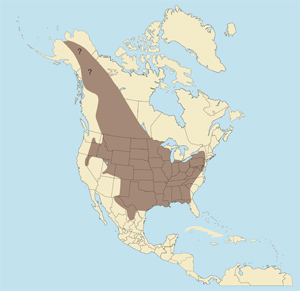 |
Bison bison
Bisonte Americano (Sp), Bison (G), Bison Nord-Américain (F). Called buffalo by most North Americans, but it is not a true buffalo like those found in Asia and Africa. Scientists tell us its forebears reached North America from Asia by crossing the Bering land bridge during the Pleistocene, some two million years ago. The American bison, and its close relative the European bison, belong to the tribe Bovini, which includes the world's cattle, buffaloes and bisons.
DESCRIPTION After the walrus, the bison is the largest North American game animal. Large bulls can measure 5-6 feet (1.5 to 1.8 m) at shoulder, and weigh 1,600-2,200 pounds (725-1,000 kg), occasionally as much as 3,000 pounds (1,350 kg). Females are much smaller, weighing about 900 pounds (400 kg) or less.
Both sexes have a large hump on the shoulders and a massive head that is carried low. The body is rather narrow in cross section, especially in the hindquarters. The head, neck, and forequarters are covered with thick, shaggy hair, and there is a short beard. The tail is short and tasseled. The summer coat is a pale yellowish-brown; the winter coat is dark brown, becoming almost black on the head and shoulders. Albinism occurs occasionally. (In the days of the plains Indians, an albino bison hide carried great spiritual significance.) Both sexes have short horns that curve out and up from the sides of the head. Females have slimmer horns, a thinner neck, and a smaller hump than males.
Compared with the European bison, the American bison is shorter and more massively built, but has slimmer hindquarters. It has a longer and thicker mane, a shorter and less bushy tail, and horns that are more curved.
BEHAVIOR One of the world's most gregarious mammals. One 19th century herd was said to be 25 miles wide and 50 miles long (40 x 80 km), containing an estimated four million animals. Although zoologists view such figures with suspicion, it is nevertheless true that very large herds did exist. Bison feed almost exclusively on grasses and drink water regularly. Unlike other hoofed mammals, they will face into a storm because the heaviest part of their coat is in front. The usual gait is a plodding five mph (8 km/h), but able to gallop as fast as 30 mph (48 km/h) if necessary. A good swimmer. Eyesight is poor, hearing is good, sense of smell is very good. Mating occurs in the summer, with a single calf born the following spring. Life expectancy 20-25 years, occasionally as much as 40 years.
HABITAT Traditionally an inhabitant of grass prairies, but bison were also found in open forests and mountainous areas.
DISTRIBUTION Within recent historical times, bison were spread over the greater part of the North American continent from the Northwest Territories (and perhaps also Alaska and the Yukon) to northern Mexico, and from eastern Oregon to the Appalachians. Now found only in parks, refuges and private ranches in Canada and the United States.
REMARKS The bison was never a difficult animal to hunt and is less so today as it is restricted to small properties. It is collected mostly for its excellent meat, or to fill out a collection, or by nostalgia buffs with primitive weapons.
TAXONOMIC NOTES Two subspecies are recognized: the plains bison (B. b. bison) was once widespread from the Rocky Mountains to the Appalachians, and from the Canadian prairies to northeastern Mexico; the larger, darker and warier wood bison (B. b. athabascae) lived farther west, extending northward as far as the Northwest Territories and possibly as far west as the Bering Sea coast of Alaska. Two other races were listed at one time but no longer are considered valid, and are extinct in any case. They were the pale-colored mountain bison (haningtoni) of Colorado, and the eastern bison (pennsylvanicus) of Pennsylvania, Maryland and Virginia, which was almost black with a grizzled face and smaller hump. There are large numbers of plains x wood bison hybrids in Yellowstone (U.S.) and Wood Buffalo (Canada) national parks and elsewhere. The only remaining pureblooded wood bison are found in sanctuaries in the Northwest Territories and Alberta. All North American bison are combined here for record-keeping purposes.
STATUS From an estimated population of 50 million-75 million prior to the arrival of Europeans in North America, bison were reduced to fewer than 1,000 animals by 1890, with most of the slaughter taking place between 1870-1884. Bison were hunted commercially for their hides and skins, and were also deliberately exterminated over large areas to subdue the native Indians, who were dependent on them, and to make way for agriculture and cattle ranching.
Today, more than 100,000 bison exist in Canada and the United States. The plains bison is secure, but the wood bison is on Appendix II of CITES (1975) and is listed as endangered by the USF&WS (1970). Canada, however, believes that its pureblooded wood bison populations are secure, and has opened limited permit hunting. Under present USFWS regulations, these animals will be importable with an import permit starting July, 2012. After new entries are received we will establish a seperate listing for the wood bison.
|




